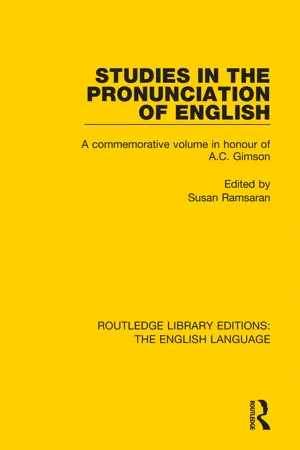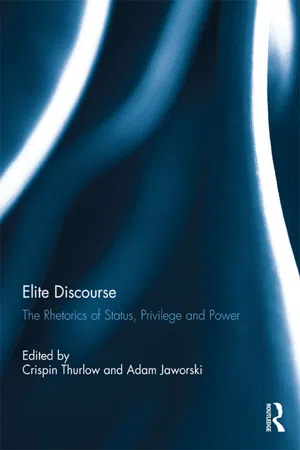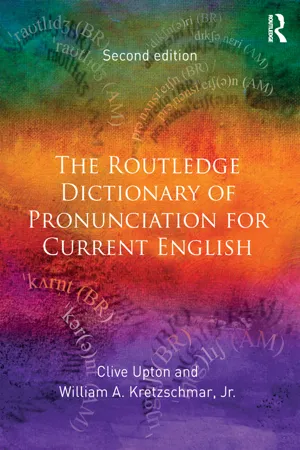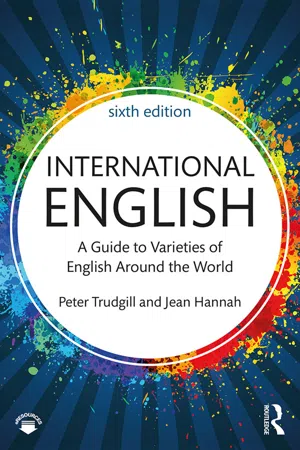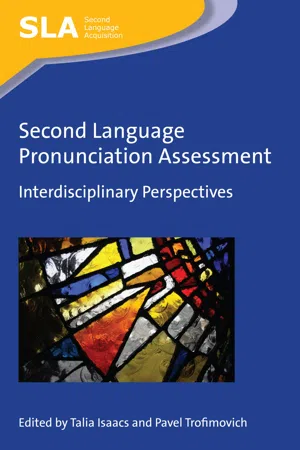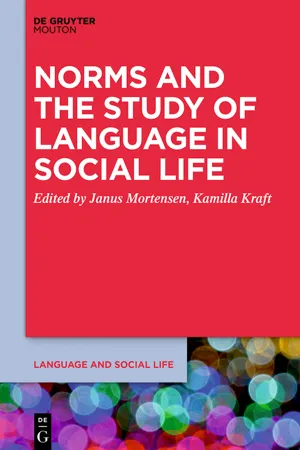Languages & Linguistics
Received Pronunciation
Received Pronunciation (RP) is a prestigious accent associated with British English, traditionally spoken by the upper class and used as a standard for teaching English pronunciation. It is characterized by non-regional pronunciation and is often associated with formality and authority. RP has been influential in shaping perceptions of "correct" English pronunciation and is commonly used in broadcasting and public speaking.
Written by Perlego with AI-assistance
Related key terms
Related key terms
1 of 4
Related key terms
1 of 3
11 Key excerpts on "Received Pronunciation"
- eBook - ePub
- Alexander Bergs, Laurel Brinton, Alexander Bergs, Laurel Brinton(Authors)
- 2017(Publication Date)
- De Gruyter Mouton(Publisher)
Lynda MugglestoneChapter 8: Received Pronunciation
Lynda Mugglestone: Oxford (UK)1Defining Received Pronunciation: an overview 2Antecedents: supra-regional attitudes 3Received Pronunciation: belief and behavior 4Modern RP: the crisis of definition 5Summary 6ReferencesAbstract :This chapter explores the history and identity of ‘Received Pronunciation’ or RP, spanning the 18th century, when comment on a non-localized British accent first appears, to contemporary discussion in terms of both usage and attitudes. Charting early attempts to disseminate and foster a reference model for spoken English, and the social meanings which could also thereby be cultivated, it also uses archive material to examine particular case-histories of its adoption and use. New archive material is also used to explore its role (and explicit fostering) in institutions such as the early BBC. Changes in modern RP (and attendant crises of definition and identity) are given careful consideration in order to evaluate the question of its continued validity, either as label or linguistic reality.1Defining Received Pronunciation: an overview 1.1Controversy and consensus
Both the identity and role of Received Pronunciation (RP) have been the subject of considerable discussion. It is “an anachronism in present-day democratic society”, Abercrombie (1965: 14) declared; “old-fashioned and misleading”, Roach (2000: viii) later concurred. Intentionally displaced by other terms (“BBC Pronunciation” [Roach 2000], “non-regional pronunciation” [Collins and Mees 2003], “Reference Pronunciation” [Rosewarne 1984]), its claims as automatic reference model in dictionaries and in foreign language teaching have likewise been contested. “If we had a completely free choice of model accent it would be possible to find more suitable ones”, Roach (2000: 5) argues, advocating Scottish or Irish accents instead. Traditional images of RP nevertheless continue, foregrounding both social evaluation and supra-regionality as salient elements in its construction (“A prestige way of speaking […] the speech of educated people, not restricted to any area of England” [Kreidler 1997: 4], “the accent spoken throughout England, by the upper-middle and upper classes […] widely used in the private sector of the education subsystem” [Giegerich 1992: 43]). Other writers actively contest the viability of socially-orientated (and especially class-based) meanings. It is “impossible actually to identify the accent under discussion in social terms”, Ramsaran (1990: 178) avers, not least since “it is no longer possible to talk in […] clear-cut terms of social classes; nor is there any longer so straightforward a correlation between social background and profession or type of education in present-day society”. Elsewhere the demise of RP is predicted – or already described – in favor of another variety of speech, widely labeled “Estuary English” (see e.g. Ballard 2001: 188). This, however, attracts its own elements of controversy: it is “a putative variety of Southern British English located in the Home Counties” (Przedlacka 2000: 19); “in reality there is no such accent, and the term should be used with care” (Roach 2000: 4). - eBook - ePub
Studies in the Pronunciation of English
A Commemorative Volume in Honour of A.C. Gimson
- Susan Ramsaran, Susan Ramsaran(Authors)
- 2015(Publication Date)
- Routledge(Publisher)
Chapter 18 . Its current status within England is a matter for objective examination and shall be left for the next chapter.Note
- This figure is Cheshire's (1984) interpretation of Trudgill (1979 : 10). Since the areas which Trudgill mentions are ones in which RP is known to be far from prevalent, it seems likely that the percentage of RP speakers in the total British population would be somewhat greater than 3%.
Passage contains an image
17
Howard Giles University of Bristol Nikolas Coupland University of Wales Institute of Science and Technology, Cardiff Karen Henwood, Jim Harriman University of Bristol and Justine Coupland University of Wales Institute of Science and Technology, Cardiff Great BritainThe social meaning of RP: an intergenerational perspective1DOI: 10.4324/9781315688367-20Research into the social evaluation of dialect has been held for considerable time (e.g. Labov 1972 ) to be a necessary counterpart to the study of social differentiation. Whatever the descriptive facts of dialect distribution, it is individuals' and groups' classifications, evaluations and responses to dialect varieties — the 'emic' dimension — that guide and constrain patterns of dialect in use (Coupland 1987 ). In the case of Received Pronunciation (RP), the evaluative focus has a particular salience. After all, as Gimson (1962 : 83) notes in the first edition of IPE, RP is equated with the 'correct' pronunciation of English, and to that extent it can be defined evaluatively. Quite plausibly, RP can, therefore, be envisaged as an accretion of evaluations, an 'ideal' variety of English pronunciation, inherently conservative but predictably varying over time and space.Gimson's key contribution has been to offer a durable detailed 'core description of RP, but without obscuring either the variability RP subsumes or the centrality of evaluative issues. He notes (1962: 82) that RP grew out of a confluence of geographical and evaluative factors — the dialect of the London area acquiring a social prestige for reasons of politics, commerce and the presence of the Court. On the other hand, Gimson points to the complexities inherent in labelling RP prestigious: 'RP itself can be a handicap if used in inappropriate social situations, since it may be taken as a mark of affectation, or a desire to emphasize social superiority' (1962: 84); RP may be rejected, for example, by the younger generation 'because of its association with the "Establishment"' (ibid.); 'the advanced speech of the young is traditionally characterized by the old as slovenly and debased' (1962: 82). In these and other comments, Gimson has presaged several central themes taken up empirically in recent sociolinguistic and social psychological studies (cf. Trudgill and Giles 1977 ; Ryan and Giles 1982 - eBook - ePub
Elite Discourse
The rhetorics of status, privilege and power
- Crispin Thurlow, Adam Jaworski, Crispin Thurlow, Adam Jaworski(Authors)
- 2018(Publication Date)
- Routledge(Publisher)
5 Note, however, the distinction he makes with a comment later in the book:At present there is no standard of pronunciation. There are many ways of pronouncing English correctly, that is according to the usage of large numbers of persons … in different parts of the country, who have received a superior education. (Ellis 1869, 630)The implication here is that there is, on the one hand, a (variable) “Received Pronunciation,” used among certain groups in the capital, but, on the other, there is not a standard pronunciation.The study and description of RP is, however, most associated with the phonetician Daniel Jones, author of the English Pronouncing Dictionary and the Outline of English Phonetics. It was only in later editions (Outline 1932, 3rd edition, English Pronunciation Dictionary 1937, 4th edition) that he used the term “Received Pronunciation” (Collins and Mees 1999, 324). In Outline, he needed to adopt a particular system of sounds in order to teach phonetics, and so chose the one most like the accent with which he – a public school and Cambridge educated man raised in leafy districts of London with an Oxbridge educated barrister father – was most familiar. He repeatedly made it clear that the main motivation for choosing the system he eventually called RP was because it was “widely understood.” RP was not “a particularly good term, but it is doubtful whether a better one can be found” (Jones 1950, 2–4). His intentions in using the label, reiterated in his own later publications, were clearly not prescriptive.It cannot be said that any particular standard exists. [In this book] is given a fairly detailed description of one form of English pronunciation which, though not a standard, can at least be said to be easily understood throughout the English speaking world … it is not the object of this book to set up this particular style of pronunciation as a standard. (Jones 1918, vi–vii)6 - Clive Upton, William A. Kretzschmar, Jr.(Authors)
- 2017(Publication Date)
- Routledge(Publisher)
Pronunciation ModelsThe British English (BR) pronunciation model
An obvious model for British English pronunciation is that which is usually termed Received Pronunciation (normally abbreviated to RP), this being ‘an accent that will not be the object of comment as regards elevated upbringing or social pretension’ and that ‘is not associated with any one geographical region in England’ (Upton 2008: 239). It may also be thought of as ‘a standard of pronunciation which is generally considered correct and is also used as a model for the teaching of English to foreigners’ (Upton et al. 2015: 4). A model labelled ‘RP’ has long been the norm in British-English pronouncing and general dictionaries and in language-teaching classrooms. In this regard transcribers of BR, with access to a generally agreed model for description, may be considered to be more fortunate than transcribers of AM, for which no nationwide model can readily be identified (p. xvii).However, problems for the transcriber of BR begin rather than end with the choice of RP as the model. It is not possible to justify the choice for British English pronunciation simply by claiming that one has selected RP: there are variations between the pronunciations of individuals who can legitimately lay claim to an RP accent. (See for example discussions by Wells 1982: 279–97, Upton 2012: 60–5, and Cruttenden 2014: 78–85 in this regard.)Within a range of RP accents two essential trends, which have been termed ‘U-RP’ and ‘mainstream RP’ (by Wells 1982) or ‘marked’ and ‘unmarked’ (by Honey 1989), are to be distinguished. The one variety (‘U’ or ‘marked’) is an accent which, when heard by most native speakers of BR, leads to the user being judged old-fashioned, affected, or pretentious. The other (‘mainstream’ or ‘unmarked’) is an accent which, for native speakers, carries connotations of education and sophistication but no especially narrow regional overtones and no serious negative social judgements. With obvious variations between individual speakers, it is the accent we hear used by many national radio and television newsreaders and by very many middle-aged and younger professional people. It might very loosely be labelled ‘broadcast RP’ if yet another label were desirable: it is reasonable to maintain, however, that since it is ‘mainstream’ and ‘unmarked’ it can legitimately lay claim to the RP label without qualification. This variety of the accent contrasts strongly with the ‘U’ or ‘marked’ accent of the previous generation of media newsreaders and of conservative (often older) RP speakers generally. And it should also not be supposed that, whether on the British Broadcasting Corporation or other British-based stations, the majority- eBook - ePub
International English
A Guide to Varieties of English Around the World
- Peter Trudgill, Jean Hannah(Authors)
- 2017(Publication Date)
- Routledge(Publisher)
(One book which attempts to help with this problem is Hughes, Trudgill and Watt, 2012.) Second, while RP is not a regional accent, it is a social accent associated particularly with the upper-middle and upper classes (and those who aspire to membership of those classes). Foreigners who are very successful at acquiring an RP accent may therefore be treated as if they were upper class, and the reaction might not always be favourable! Third, the RP accent is probably rather more difficult for many foreigners to acquire than, say, a Scottish accent, since RP has a large number of diphthongs and a not particularly close relationship to English orthography. 2.1.1 The RP vowel system The RP vowel system is presented in Table 2.1 and can also be heard on the recording. While RP does not have any regional variation, as we have said, it does have variation of other types. In particular, there is variation between what some writers have called ‘conservative’ and ‘advanced’ RP (see Cruttenden, 2014, and Wells, 1982). For the most part, this reflects linguistic changes that are currently taking place in RP, with ‘conservative’ pronunciations being most typical of older speakers and ‘advanced’ pronunciations typical of younger speakers. Some of these differences are the following: 1 As in a number of other accents, the distinction between /ɔə/ and /ɔ:/ is now lost for very many speakers, with /ɔə/ becoming monophthongized. A more recent, but by now also widespread development, is the loss of /ʊɔ/ and the merger of this diphthong, also, with /ɔ:/. This latter change for some speakers has affected some words but not others so that sure may be /∫ɔ:/ but poor /pʊə/ - eBook - ePub
- Natalie Braber, Sandra Jansen, Natalie Braber, Sandra Jansen(Authors)
- 2018(Publication Date)
- Palgrave Macmillan(Publisher)
© The Author(s) 2018Begin AbstractSociolinguistics in England https://doi.org/10.1057/978-1-137-56288-3_3Natalie Braber andSandra Jansen (eds.)3. Social Change, Linguistic Change and Sociolinguistic Change in Received Pronunciation
End AbstractAnne H. Fabricius1(1) Roskilde University, Roskilde, DenmarkAnne H. FabriciusIntroduction
In this chapter, I examine one sociolinguistic niche that has been somewhat downplayed in mainstream work, but as I will show below, it is one that has interesting ramifications for an understanding of the complexity of language in social life and the progression of linguistic change. The focus here is on the elite sociolect of the UK, the generational successor to Received Pronunciation (RP), also known as Standard Southern British English (SSBE). Taking a viewpoint that social class (admittedly a complex concept, as the debates in Skeggs 2015 show) continues to manifest in sociolinguistic life in the UK, I examine here a selected set of sociophonetic changes that characterise the history of the elite sociolect. It is trivially true that all language varieties change; the point of interest in this chapter is the sociolinguistic ramifications of the continued existence of elite sociolects, and whether they continue to signal and construct social difference in the community. Our claim here is that, far from being entirely levelled to other social varieties in the south of England, for example, these voices are still distinct and sociolinguistically significant.Theoretical Preliminaries
Fifty years of sociolinguistic research have shown how we can see language practice, language ideology, social fabric and social practice as intertwined, mutually constitutive semiotic processes ebbing and flowing in the course of history (Labov 1994 , 2001 ; Eckert 2008 ). Social processes such as large-scale urbanisation in the nineteenth and twentieth centuries, the upheavals of the Second World War and de-industrialisation in the late twentieth century had large impacts upon the human landscape of Britain, with waves of de-dialectalisation, dialect levelling and regionalisation as some of the sociolinguistic consequences (Trudgill 1986 ; Britain 2016 ; Coupland 2014 , 2016 ). Multi-ethnic immigration is also presently bringing about linguistic transformations of many kinds (this is especially well researched in the UK: see e.g. Cheshire et al. 2011 ; Rampton 2011 ; Kerswill 2013 - eBook - ePub
International English
A guide to the varieties of Standard English
- Peter Trudgill, Jean Hannah(Authors)
- 2013(Publication Date)
- Routledge(Publisher)
always be favourable! Third, the RP accent is probably rather more difficult for many foreigners to acquire than, say, a Scottish accent, since RP has a large number of diphthongs and a not particularly close relationship to English orthography.2.1.1. The RP Vowel SystemThe RP vowel system is presented in Table 2.1 and can also be heard on the recording. While RP does not have any regional variation, as we have said, it does have variation of other types. In particular, there is variation between what some writers have called ‘conservative’ and ‘advanced’ RP (see Cruttenden and Gimson, 2008, and Wells, 1982). For the most part this reflects linguistic changes that are currently taking place in RP, with ‘conservative’ pronunciations being most typical of older speakers and ‘advanced’ pronunciations typical of younger speakers. Some of these differences are the following:Table 2.1 .The RP vowel system*/ɪ /bid, very , mi rror, wante d, horse s, hone st /ε /bed, merry/æ/ bad, marry/ɒ /pot, long, cough, horrid/ʌ /putt, hurry/ʊ /put/i:/ bee/ei/ bay/ai/ buy/ɔ i/boy/u:/ boot/ou/ boat/au/ bout/ɪ ə /peer, idea/ε ə /pair, Mary/ʊ ə /poor/ɔ ə /pore/ɔ :/paw, port, talk, boring/a:/ bard, path, dance, half, bana na, father, calm /ɜ :/bird, furry/ə /a bout, sofa , butte r /aiə /fire/auə /tower* The words in Table 2.1 - eBook - ePub
Second Language Pronunciation Assessment
Interdisciplinary Perspectives
- Talia Isaacs, Pavel Trofimovich, Talia Isaacs, Pavel Trofimovich(Authors)
- 2016(Publication Date)
- Multilingual Matters(Publisher)
Such attempts at accommodation are usually examined with regard to a non-prestige L1 accent. But it also applies to foreign accents. After all, just as an L1 accent defines one’s provenance, so too does an L2 foreign accent, which is often shared with family and peers and even larger social and regional groups. Thus, it is possible for most of us to label a speaker of English with a foreign accent as, say, French; it is also possible for a phonologist to point to a much narrower background, say, Provencal or Normandy French. So what is accent? David Crystal defines accent thus:The cumulative auditory effect of those features of pronunciation which identify where a person is from, regionally or socially … the term refers to pronunciation only, it is thus distinct from dialect, which refers to grammar and vocabulary as well. … In Britain, the best example is the regionally neutral accent associated with a public school education, and of the related professional domains, such as the Civil Service, the law courts, the Court and the BBC: hence the labels Queen’s English, BBC English, and the like. Received Pronunciation (RP) is the name given to this accent and because of its regional neutrality, RP speakers are sometimes thought of as having no accent. This is a misleading way of putting it, however: linguistics stresses that everyone must have an accent, though it may not indicate regional origin. (Crystal, 1997: 2)Many years ago, I was invited by the West African Examinations Council to advise on the introduction of a compulsory spoken English test at school certificate level, effectively the final examination at secondary school and the examination that, at that time, determined entry to university. There was a test already in use, the McCallien Test, but this was regarded as in need of renewal. It tested only RP segmental sounds and was too difficult for the majority of students who had no contact with RP. McCallien herself had an educated Scottish English accent, certainly not RP; the teachers of those presenting for the examination spoke with some form of West African accent. And so, the assumed goal of the test was not available to most students. The McCallien Test also left out all other aspects of spoken communication. We proposed a new test which used as a norm an educated West African accent. But there was little appetite for such a change: stakeholders were worried that to promulgate one or more West African norms might ghettoize West African speakers of English, who would be labelled as second-class English speakers. The initiative collapsed; for me the experience illustrated the difficulty of change in norm setting. - eBook - ePub
English Accents and Dialects
An Introduction to Social and Regional Varieties of English in the British Isles, Fifth Edition
- Arthur Hughes, Peter Trudgill, Dominic Watt(Authors)
- 2013(Publication Date)
- Routledge(Publisher)
2000 ).A third factor is the age at which a person began to acquire an RP accent. Those who acquire it after childhood are likely to avoid normal features of faster RP speech, such as the dropping of unaccented /h/ in pronouns.Other personal factors include the particular school attended; the speaker’s profession or role; personality (a fastidious person may avoid something they consider vulgar, such as use of glottal stops for /t/ in certain environments); attitudes to language and to other speakers of RP; the frequency with which a speaker uses a word (less frequently used words being less likely to participate in a general change of pronunciation – for example, for some speakers at least, heir is less likely to be monophthongised than air); and even what a person has been told, perhaps by a teacher, is the ‘correct’ pronunciation of a word.Other authors have concentrated on some of these factors in identifying subvarieties of RP. For Gimson (1988 ) there were three main types: conservative RP, spoken by the older generation and certain professional and social groups; general RP, the least marked variety; and advanced RP, spoken by younger members of exclusive social groups. Cruttenden’s (2001 ) revision of Gimson’s book uses the labels General, Refined and Regional RP. Cruttenden’s Refined RP is equivalent to Gimson’s conservative RP, while his apparently contradictory Regional RP refers to ‘the type of speech which is basically RP except for the presence of a few regional characteristics which go unnoticed even by other speakers of RP’ (Cruttenden 2001 : 80). These, he argues, include features like the use of /l/-vocalisation, whereby a word-final /l/ is realised as a vowel such as [ʊ] to give, for example, [bɔʊ] for ball - eBook - ePub
- Janus Mortensen, Kamilla Kraft(Authors)
- 2022(Publication Date)
- De Gruyter Mouton(Publisher)
Cockney, Scouse). It makes an explicit distinction between RP as “a vernacular” (phonetic features as part of a first language of socialization) and RP as an abstract, more-or-less explicitly codified and enregistered folk-linguistic model (which can however also be someone’s vernacular). Construct-RP, the abstract notion of RP’s linguistic form and status is just as much a property of the speech community (at whatever scale) as the vernacular form, native-RP.Agha (2003; 2007) introduced the concept of the enregistered RP voice – what I would call construct-RP – in his presentation of the term enregisterment. He claims that (construct) RP became enregistered as a folk concept over the span of the nineteenth century, meaning that it became a recognized set of phonetic patterns. This process is described for example in macro-sociolinguistic and micro-phonetic terms in Mugglestone’s (2003) Talking proper. The enregistered/construct RP came to embody a certain type of voice, in folk terms, suited to a certain setting, resonant of a certain type of person or persona (see for example Agha’s characterological figure Mr Round; Agha 2003 , 2007 ). As a spoken register, RP was immediately available to the BBC in the 1920s (Schwyter 2016 ) as a normative model. However, as Schwyter shows, the corporation’s own Advisory Committee on Spoken English actually had major difficulties in reaching agreement on specific pronunciation norms throughout its lifespan (which ran from 1926 to 1939). This may to some extent cast doubt on the claim that the enregistered RP voice at that time really was a shared sociolinguistic construct; Schwyter’s data suggests it was mostly on the level of non-systematic lexical variations in pronunciation that disputes occurred. In any case, Agha’s concept of the enregistered voice was indeed part of what I intended the term construct-RP to cover in Fabricius (2000 , 2002a , 2005 ), but construct-RP was also defined to include codified manuals and dictionaries of the accent as explicit models. These are called text-artifacts in Agha’s anthropological perspective: they themselves also function as further vehicles of enregisterment processes (see further Fabricius 2018 - eBook - ePub
Language Awareness at School
A Practical Guide for Teachers and School Leaders
- Tim Marr, Steve Collins(Authors)
- 2023(Publication Date)
- Routledge(Publisher)
But this is to misunderstand the nature of English spelling. Unlike in Spanish or Finnish or Turkish, say, in English nobody systematically pronounces words exactly as they are written, because the writing system in English does not simply mirror the spoken word. So speakers of Received Pronunciation (RP) do not pronounce all words as they are spelt, either. For example, unlike most Americans, they don’t pronounce the /r/ sounds in words like doctor or partner – so they sound a bit like ‘doct-uh’ (/ˈdɒktə/) and ‘paht-nuh’ (/ˈpɑ:tnə/). 18 And, of course, absolutely no one argues on this account that middle-class RP-speakers are not pronouncing the words properly! And so we see how the notion of ‘speaking in complete sentences’ is linked organically to a confusion between speaking and writing, and how both are rooted in a frustratingly widespread lack of language awareness. If the desired outcome is to help students write and speak in ways appropriate to context, then the solution to the whole problem lies in developing linguistically informed approaches to the teaching of literacy and oracy. It is not fair, accurate or helpful to tell students who use non-standard dialect forms that they are speaking wrongly, or to insist that everyone must use Standard English at all times. And it is certainly not helpful to impose a strange and unnatural ‘full sentences only’ rule which forces speech into the straitjacket of formal writing and casts normal spoken language behaviour as somehow incompetent or inadequate. Linguistically aware teachers work with the grain of language, not against it. 2.4 Attitudes to speaking (or speakin’) In my first year at secondary school, I (Tim) remember being taken aside by a particular teacher and told quite aggressively and impatiently that I had an ugly and sloppy Yorkshire accent, which I would do well to get rid of
Index pages curate the most relevant extracts from our library of academic textbooks. They’ve been created using an in-house natural language model (NLM), each adding context and meaning to key research topics.
Explore more topic indexes
Explore more topic indexes
1 of 6
Explore more topic indexes
1 of 4

